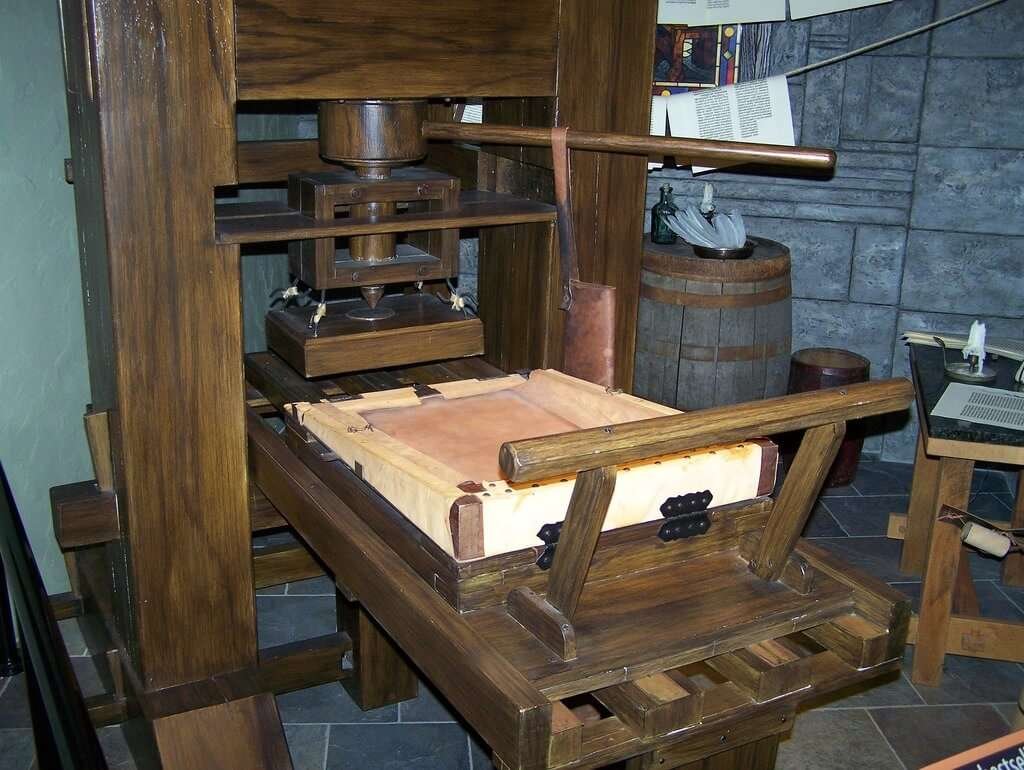The invention of the printing press was one of history’s pivotal moments, revolutionizing how information was disseminated and consumed. It laid the groundwork for modern society’s rapid technological, scientific, and cultural progress. This article will investigate its origins, impact on society, and various types of printing presses that emerged as a result of this groundbreaking discovery.

The Inception Of The Printing Press
What began as a simple idea has evolved into what we now know as modern print technology, providing us with access to millions of designs in just minutes. Johannes Gutenberg, a German goldsmith, and inventor invented the printing press in the mid-15th century. While other countries had attempted to print before him, Gutenberg’s invention of the movable type printing press is widely seen as having started the European printing revolution.
Gutenberg’s press utilized individual, reusable metal letters arranged on a wooden frame. These are inked and pressed onto paper for efficient production of printed materials. The first book known to have been printed using Gutenberg’s press was the bible itself – now popularly referred to as the Gutenberg bible – which was completed around 1455.
Predecessors And Early Print Technologies
Before Gutenberg’s invention, various printing forms had been developed worldwide. China produced the first known printed text, the diamond sutra, in 868 ad using woodblock printing – carving an entire page of text or images onto a wooden block, inking it, and pressing it onto paper or cloth. While woodblock printing could create multiple copies quickly and accurately, each block must be individually carved by hand for optimal efficiency.

In Korea, the Jikji, a Buddhist document, was printed using movable metal type in 1377 – nearly 200 years before Gutenberg’s press was invented. Despite these earlier innovations, Gutenberg’s adaptation of movable type and development of the printing press enabled the rapid dissemination of knowledge throughout Europe. Following Gutenberg’s invention, various printing presses were developed to meet the growing demand for printed materials. These presses built upon and improved his original design, leading to faster and more efficient production processes.
Rotary Press
In the early 19th century by American inventor Richard march hoe, the rotary press consisted of a continuous roll of paper fed through two cylinders – one carrying type and the other applying pressure. This design enabled significant increases in printing speed, making it ideal for producing newspapers and other high-volume materials such as packaging.
Lithography
Lithography was invented in 1796 by German author and actor Alois Senefelder as a printing process that utilizes flat stone or metal plates with images drawn on their surfaces using an oily substance. Water is applied to the surface, with ink adhering only to those areas with grease, allowing the image to be transferred onto paper – perfect for illustrations, maps, and posters! This method has become particularly popular since then due to its ease of reproducibility.

Intaglio
Intaglio printing involves carving an image into a metal plate, usually copper or zinc. Ink is applied to fill in any carved lines, and then the surface is wiped clean, leaving only ink in recessed areas. The paper then presses onto this raised image created by pressing onto the plate – commonly used for high-quality art prints, banknotes, and postage stamps.
Offset Printing
In 1904, American printer ira rubel invented offset printing – an indirect method that transfers inked images from plates onto rubber blankets and paper. This prevents the ink from spreading too widely and maintains great detail and consistency in the printed image. Offset printing has since been widely employed for mass-produced materials like books, magazines, and packaging.
Digital Printing
Digital printing evolved in the latter part of the 20th century with advances in computer technology. This method does not need a physical plate or stencil; images are transferred directly from digital files onto printing media using inkjet or laser printers. Digital printing offers greater versatility, faster turnaround times, and the flexibility to modify designs easily – making it ideal for on-demand or personalized printing needs.

Impact Of Printing On Society
The invention of the printing press had far-reaching implications on society, both short and long-term. It enabled mass production and dissemination of information, leading to increased literacy rates, knowledge diffusion, and democratization in education. Furthermore, its rapid exchange of ideas fostered intellectual and scientific advances shaping history’s course.
Furthermore, the printing press played a pivotal role in the protestant reformation by enabling the widespread distribution of religious texts such as Martin Luther’s ninety-five theses. This accessibility to spiritual materials allowed individuals to engage with religion directly, challenging the authority of the catholic church and ultimately leading to the formation of various protestant denominations.
Final Thoughts
Johannes Gutenberg’s invention of the printing press in the mid-15th century marked a significant turning point in human history, revolutionizing how information was produced and disseminated. Over time, various printing presses emerged to allow faster, more efficient, and more diverse output – allowing knowledge to spread more widely than ever before. This invention undoubtedly laid the foundations for modern culture, technology, and science as we know it today – still shaping our world today.
Also Read: Who Invented Egyptian Mathematics?
